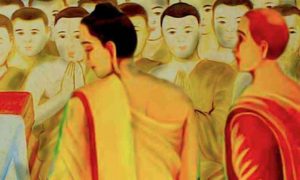
Editor’s note: This article was first published in the now-retired Bodhi Journal, Issue 8, June 2008.
Introduction
According to Edward Conze, the Prajñ?p?ramit? literature extended over 1,000 years and can be roughly divided into 4 phases of development:
1. The first phase consists of the elaboration of basic text (ca 100 BCE to 100 CE);
2. The second phase witnesses the expansion of the text into three or four lengthy treatises (ca 100 CE to 300 CE);
3. The third phase consists of the restatement of the teaching into few shorter s?tras.
4. The four phase is the period of Tantric influence where the text was condensed into dh?ra??s and mantras.
A?tas?hasrik? Prajñ?p?ramit? (AP) which is rightly translated as ‘The Perfection of Wisdom in Eight Thousand Line’ contained in 32 Chapters is the oldest Prajñ?p?ramit?text.
AP S?tra is presented in two forms, one in verse and another in prose. The verse form of this S?tra is handed down to us under the name ofPrajñ?p?ramit?-Ratnagu?asa?cayag?tha. It consists of 302 ‘Verses on the Perfection of Wisdom Which is the Storehouse of Precious Virtues’, in which the 41 verses of the first two chapters are opined by Conze (1978) as the original Prajñ?p?ramit? which may well go back to 100 B.C.[1] All others are just elaborations. The parts of AP in chapters 1-28 are considered early, and correspond to Chapters 1-2 ofRatnagu?asa?cayag?tha, while chapters 29-32 of AP are obviously later than the remainder of the book[2] .
Being one of the earliest Mah?y?na s?tras, what then is the extent of its originality of Mah?y?na ideas? Is AP just a reinterpretation of early Buddhist teachings, or are there new things introduced in the early layers of the s?tras? To answer these questions, it is worthwhile to look at what have been discovered by the scholars like Edward Conze and Lewis R. Lancaster.
Prajñ?p?ramit?-Ratnagu?asa?cayag?tha
The first two chapters of Ratnagu?asa?cayag?tha, according to Edward Conze (i) introduce four new key terms; (ii) further develop certain ideas of the H?nay?nese; and (iii) indicate new source of teaching (Edward Conze thinks that this S?tra assumes that all worth-while knowledge is due to revelation)[3] . The new key-terms arebodhisattva and mah?sattva, by which the newly developed Mah?y?nese proclaiming its allegiance to a new type of saint, departing from the preceding conception of “Arhats”. Then, we have bodhiy?na which proclaims a new goal on a par with the full enlightenment of the Buddha; and sarvajñat?m ca parig??h??ti ?ik?am?no which means ‘and fully grasps the All-knowledge by this training’. This is where we sense the Buddha as omniscience, as distinct from that of other saints, leaning towards the Buddhological concept of the Mah?s??ghikas. The fourth term, which is mentioned 11 times in the 41 verses of these two chapters – prajñavarap?ramit?ya cary?, is a Buddhist Hybrid Sanskrit which means “the practice of wisdom, the highest perfection” as rightly translated by Conze[4] .
The new key-terms are to be found in the verse 16-23 of chapter 1, and the remainder of the two chapters with the doubtful exception of tathat?, is just simple reinstatement of the earlier Buddhist teachings. There are three topics which dominate the argument: (i) The all-important problem of self [where there is an emphasis on the achievement of the Bodhisattva who comprehends the dharmas as he should – “does not retire to into Blessed Rest. In wisdom he dwells.”, in contrast to a particular wanderer, ?ere?ika who stopped short at the understanding of pudgalanair?tmya (insubstantiality of being)]; (ii) Three aspects of the attitude a wise person should adopt towards all phenomena [namely aniketac?ri, practice of non-apprehension (anupalabdhi), and treating all phenomena as illusory (m?y?)]; (iii) Interpretation or rather reinterpretation of the higher stages of the Path. I would like to expand our discussion on the last topic of the argument particularly on definition ofNirv??a.
Meaning of Nirv??a
In chapter 1 verse 22 of Rat?agu?asa?cayag?tha, there is an explanation on the meaning of Nirv??a: “Thus transcending the world, he eludes our apprehensions. ‘He goes to Nirv??a,’ but no one can say where he went to. A fire’s extinguished, but where, do we ask, has it gone to? Likewise, how can we find him who has found the Rest of the Blessed?” Conze (1968) claims that there is nothing original about this, and he relates it to one of the best-known passages of Suttanip?ta (vv. 1074, 1076) as just a variation of it[5] :
“‘Just as a flame tossed about by the force of the wind, Upas?va,’ said by the Blessed One, ‘goes out and no longer counts as a flame, so a sage released from his mental body goes out and no longer counts as a sage.’”
Sn.v.1074
“’There is no measuring of one who has gone out, Upas?va,’ said the Blessed One. ‘That no longer exists for him by which they might speak of him. When all phenomena have been removed, then all ways of speaking are also removed.’”
Sn.v.1076
However, interestingly, if we look at the AP itself, the chapter 2 (on “The Saints and Their Goal are Illusion”) speaks of Nirv??a even as a magical illusion, like a dream. And that various classes of saints, from Stream-winner to Buddhahood are also like a magical illusion, like a dream. Although it sounds like a metaphysical speculation, it may not be the case; it could be related to a meditative insight instead. And probably from this interpretation of Nirv??a, N?g?rjuna got his inspiration for expounding the teaching of Nirv??a and Sa?s?ra as being the same [both are illusory, both are anutp?da (unarising)]. While the traditional meaning of Nirv???a was kept intact, there seems to be a reasonable effort by the author of AP to break away from the final shackle of attachment, leaping into the realm of perfect wisdom.
Conception of Dharma-k?ya and its changes within AP
According to Lancaster (1975)[6] , only in the later part of AP, there is the theory of the two bodies of the Buddha, the r?pa-k?ya and the Dharma-k?ya. From his study of the Lokak?ema text, the earliest ideas in Mah?y?na s³tras contain only one Buddha body. The body of the Buddha is described as bound by the chain of causation similar to all other physical bodies, but with the results of many lifetimes of meritorious act, there is a glorified and perfected r?pa-k?ya. In the early translations of the AP, the conception of the abstract Dharma-k?ya of the Buddha is absent, with one exception in the passage where Dharma-k?ya is translated as “the collection of Buddha’s s?tras”. Hence, we can conclude that the earliest Mah?y?na ideas pertaining to the body of Buddha is nothing different from that of the H?nay?na, at least according to the contents in theprajñ?p?ramit? texts.
Conze (1968) seems difficult to believe that the historical Buddha had actually preached these texts (perhaps by looking at the size of the texts itself). This of course has been ignored in the first two chapters ofRatnagu?asa?cayag?tha, but to him it is necessary to think out a new Buddhology and introduce some kind of “direct transmission from mind to mind” that was effected by the doctrine of Dharma-k?ya in the later part of the texts[7] .
Conclusion
It is the wondrously profound wisdom that will ‘ship’ one to the Other Shore that the AP is trying to ‘preach’ to its audience. It mediates the transition between the archaic Buddhist thought and the innovative novelty among those who were unsettled with the traditionally acclaimed Goal. Prajñ?p?ramit? texts themselves are very complicated, ‘perfumed’ with layers and layers of development over a 1,000 years long. It is essential to examine the earliest layers of the texts to analyse what had happened during the transition period. We see the preservation of some early Buddhist thoughts in this layer (traditional definition of Nirv??a and Dharma-k?yaconcept), while the efforts of introducing the new concepts have begun to find their way here. The change might be a result of being contended to meet the demands of the milieu for a ‘not so common’ Goal.
Editor’s Note
When a Mah?y?na S?tra is enlarged, there is propensity among common Buddhist learners to conceive erroneously and accuse that the s?tra was fabricated. Such misinterpretation or mispresentation vanishes when a Buddhist learner apprehends that the ancient Indian religious philosophers advocated a religious tradition or norm of composing commentaries. These commentaries are further commented upon by sub-commentaries as further exegesis or elaborations to the original religious s?tra. Such ancient Indian commentarial literature civilization of composing commentaries after commentaries resulted in the production of voluminuous s?tras. The voluminuous exegetical literature are detailed exposition of what were spoken in brief by ??kyamuni Buddha. Without the aids of exegetical literature, the obstruse Word of the Tath?gata could not be easily comprehended. The development of ancient Vedas till the consummation of the Ved?nta of ancient Brahminism and modern Hinduism bears convincing witness to this ancient Indian exegetical literature civilization.
The writer is currently working as a pharmacist in Singapore. He has a MA degree in Buddhist studies from the Post-graduate Institute of P?li and Buddhist Studies of Kelaniya University, one of the eminent centres of Buddhist Studies in Sri Lanka.
Bibliography
Conze, Edward. The Prajñ?p?ramit? Literature. Second Edition, Revised and Enlarged. Tokyo: The Reiyukai, 1978.
Conze, Edward. Thirty Years of Buddhist Studies. Columbia, SC: University of South Carolina Press, 1968.
Conze, Edward, trans. The Perfection of Wisdom in Eight Thousand Lines and its Verse Summary. Bolinas, CA: Four Seasons Foundation, 1973.
Lancaster, Lewis. The Oldest Mahayana Sutra: It’s Significance for the Study of Buddhist Development. The Eastern Buddhist. New Series 3: 1. 1975. (30-41).
Norman, K.R., trans. The Rhinoceros Horn and Other Early Buddhist Poems (Sutta Nip?ta). The P?li Text Society, London, 1985.
1. The Perfection of Wisdom in Eight Thousand Lines and Its Verse Summary, Preface ix-xi.
2. The Prajñ?p?ramit? Literature, p.8
3. Thirty years of Buddhist Studies p.124-130
4. The Perfection of Wisdom in Eight Thousand Lines & Its Verse Summary, Chapter I-II of Ratnagu?asa?cayag?th?
5. Taken from The Rhinoceros Horn and other early Buddhist Poems (Sutta Nip?ta) translated by K.R. Norman, V.7 (Upas²va’s Questions), p.170.
6. Lancaster, p.36-37
7. Thirty years of Buddhist Studies p.130











